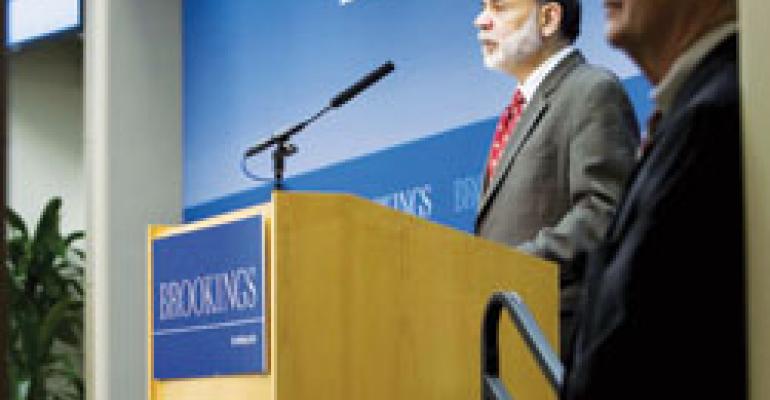The “Great Recession” is apparently over, and we’re on the long and inevitably bumpy road to recovery.
Or did we miss the exit?
Ben Bernanke, Federal Reserve chairman, last month reportedly declared the recession “very likely over.”
But as Tom Davin, chief executive of Panda Restaurant Group Inc., based in Rosemead, Calif., says: “That’s the banker and economist point of view. Maybe it means things have stopped getting worse.”
Still, there are signs of hope.
Existing-home sales reached a two-year high in July, posting a 7.2-percent increase over the prior year, and sale prices reportedly rose in June in nearly 20 cities, according to Standard & Poor’s Case-Shiller’s home price index. Case-Shiller credited the $8,000 tax credit for first-time home buyers that expires in November as prompting home sales and boosting prices.
In other good news, national housing foreclosure rates dipped slightly—less than 1 percent—in August compared with July, though more than 358,471 homeowners received default notices, or lost their homes to auctions or bank repossessions during the month. The rate is still 18 percent higher than a year ago, according to RealtyTrac’s U.S. Foreclosure Market Report.
And consumer spending reportedly was up 0.2 percent in July, in part because of the government’s “Cash For Clunkers” program, which helped boost car sales.
For the restaurant industry, however, the sales that began slowing months before the market crisis of fall 2008 do not appear to be accelerating anytime soon.
The technical recovery to which Bernanke referred “does not make consumers feel like they can go back to eating in restaurants, buying in retail stores and feeling like things are normal again,” says Dennis Lombardi, executive vice president of foodservice strategies for WD Partners, a consulting firm based in Columbus, Ohio.
“Most Americans, I’d say 80 percent to 90 percent, still think we’re in a recession,” Lombardi adds. “So if they think we’re still in a recession, we probably are.”
The “real” recovery is tied directly to job growth, Lombardi says.
Carlos Herrera, manager of industry forecasting for Coca-Cola Foodservice and On-Premise, says: “If past history repeats itself, recovery for restaurants should be consistent with the recovery of employment. In other words, meals at commercial restaurants should recover around the time jobs start to recover.”
Last month, Bernanke warned that “it’s still going to feel like a very weak economy for some time, as many people will still find that their job security and their employment status is not what they wish it was.”
Last month, President Obama told CNN that the nation is not likely to see large-scale job growth until 2010, and the employment picture may look even worse over the next few months.
According to the U.S. Bureau of Labor Statistics, nonfarm payroll employment continued to decline in August by 216,000 jobs, and the nation’s unemployment rate rose to 9.7 percent—although the rate of job losses has slowed in recent months.
Lombardi contends that consumers will need to see job growth move in a positive direction for several months before they start feeling confident about spending again.
“They need to feel like they’re not going to lose their jobs, or that they’ll be able to find a job, if they’re unemployed,” he says.
Younger consumers likely would be willing to spend more sooner, Lombardi says.
“Baby Boomers are realizing right now that they’re woefully unprepared for retirement,” he says. “It’ll take longer for them to come out of the foxhole.”
Research firm Technomic is predicting another difficult year for operators in 2010, marking the first time the industry has seen two consecutive years of sales declines.
This year, foodservice sales are expected to decrease a nominal 3.8 percent to $588.5 billion, including the assumption of a 2.5-percent menu-price increase on average. For 2010, projections include a 0.8-percent nominal decline in food-service sales, reflecting an estimated inflation rate of 1.5 percent.
Technomic officials do not expect sales to turn positive until late 2011 or early 2012, but operators are more hopeful, saying in a recent survey by the research firm that they expect to see some indication of recovery next year. The survey is part of Technomic’s annual “U.S. Forecast and Outlook” report, which is sponsored by the International Foodservice Manufacturers Association and was released in September.
In 2009, many companies have benefited from lower commodity costs, and restaurants have learned how to operate at lower volumes, operators say.
Some, like Steve Carley, chief executive of El Pollo Loco, wonder if the recession has caused a more fundamental change in attitudes about spending. Many who lived through the Great Depression, for example, never lost an ingrained sense of frugality.
Davin of Panda Restaurant Group is among the optimists. He says he does not believe Americans have fundamentally changed their ways as consumers.
“They’re savers now, but people do want to spend; it’s the American way,” he says. “When things improve, they will want to treat themselves to full-service meals again.”
Still, Davin believes that “bling,” or “extravagance for extravagance’ sake,” is not coming back anytime soon.
For restaurants, that will mean a continued focus on value and cutting discretionary costs at the operations level.
Herrera adds that Coca-Cola has been working with clients to help them tap into a broader sense of value by delivering on experience or added convenience.
“For example, guests pay more for smoothies because they see value in…how it adds to their experience,” he says.
Adds Lombardi: “The world has changed. Change with it.”— [email protected]

